Recent Articles
Popular Makes
Body Types
2017 Volkswagen Golf GTI Road Test and Review
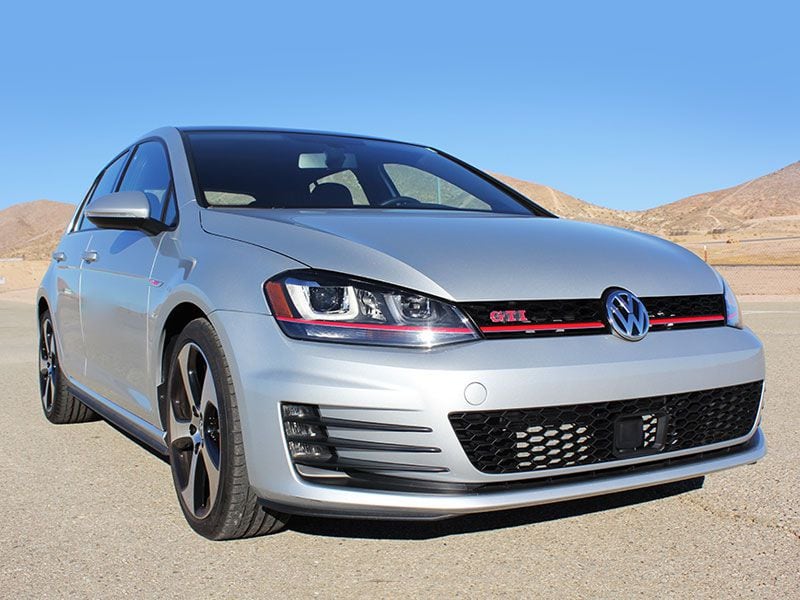
2017 Volkswagen Golf GTI exterior front angle by Miles Branman ・ Photo by Miles Branman
If you’re the automotive expert in your circle of family or friends, you've been approached for car-buying advice. “I want something fast, affordable, and versatile,” they’ll say. “Please don’t recommend anything with spoilers,” might be another qualifier.
That's when I pull the Volkswagen Golf GTI out of my memory bank like a utility knife. This performance-oriented 5-door inherently addresses the need for versatility and fun on a budget, and it does so in a mature and handsome way.
The GTI is the hot-hatch benchmark; VW created the segment in 1976, and with each successive generation the original promise of front-wheel-drive excitement has been finely honed. There are more than a few competitors for the GTI these days, so let's spend some time in its cozy sport seats to see if this VW is still worthy of enthusiasts’ default praise.
New For 2017
The Golf GTI carries over relatively unchanged for the 2017 model year, but Volkswagen has thoroughly streamlined its pricing and packaging to make the no-brainer hot hatch that much easier of a buying decision. The biggest difference for 2017 : You can no longer opt for the 3-door GTI with the acclaimed Performance Pack. If you’re dead-set on a 3-door GTI, you’ll have to settle for a base-spec S trim. The cheapest way to get the Performance Pack’s additional 10 horsepower, limited-slip differential, and Golf R brakes is now with the new Sport trim. Sitting above the Sport is an SE trim, with more standard equipment (including leather seats). Finally, the range-topping Autobahn includes every available goody except for a more advanced set of driver assistance features.
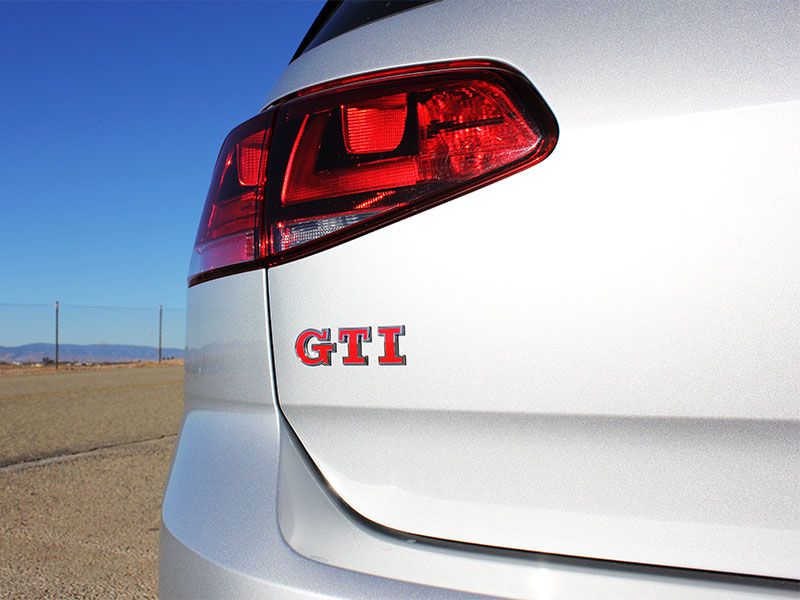
Photo by Miles Branman
Performance
Since VW introduced the Golf R (preceded by the R32), the Golf GTI has played second fiddle in outright performance. However, the Golf R’s all-wheel-drive system adds weight and changes the driving experience considerably. For traditional front-wheel-drive fun, at thousands less than the R, the GTI still has the goods. Entry-spec GTI’s develop 210 hp and 258 lb.-ft. of torque from a 2.0-liter turbocharged 4-cylinder engine. Sport, SE, and Autobahn versions gain an additional 10 hp but maintain the torque figure. More potent GTI models make the sprint to 60 mph in as little as 5.5 seconds (depending on transmission) and are electronically limited to 130 mph. Despite a whisper of turbo lag, the GTI is impressively quick from any rolling speed. One complaint about the GTI's electronic stabilization program (ESP). While drivers can turn off the car’s ASR (anti-slip regulation, or traction control) fully, the ESP can only be configured to “Sport” mode, where traction control will allow some slip before intervening. While certainly less invasive than full ESP, Sport mode will still cut power and apply braking during aggressive maneuvers. That stated, the GTI perfectly manages torque steer, and it carves corners better than some purpose-built sports cars. It also has plenty of stopping power.

Photo by Miles Branman
DSG vs. Manual
I'm not the first person to tell you that modern automatics and dual-clutch transmissions shift gears more quickly than most humans can with a manual. Faster shifts usually translate to a quicker 0–60 MPH time, yet the Golf GTI remains faster with a stick. What’s more, 6-speed manual GTIs return 24 MPG city and 34 MPG highway, versus the DSG’s (direct-shift gearbox) 24/32 figures. If you need more of a reason to opt for the manual transmission, let the DSG’s additional $1100 price guide your purchasing decision. If you absolutely must have an auto box, however, Volkswagen’s unit is one of the smoothest on the market, having been improved since 2006.
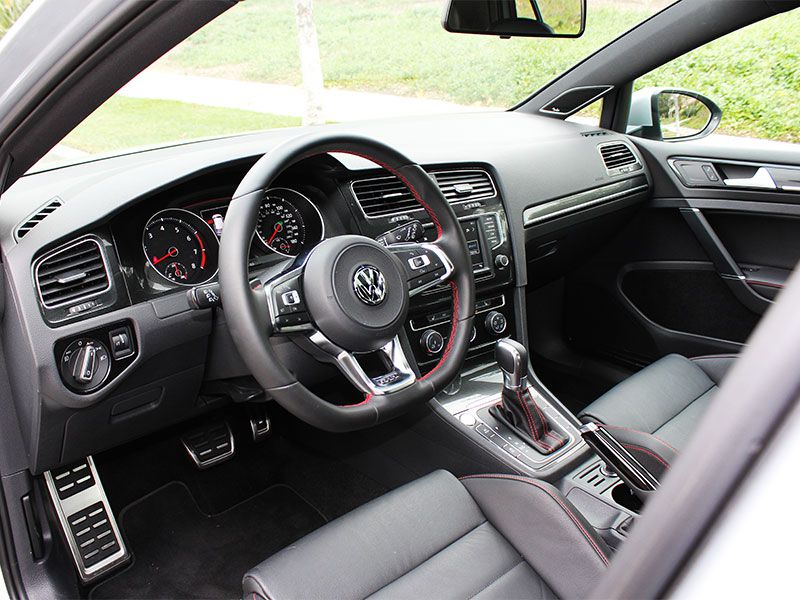
Photo by Miles Branman
Mature Styling
Since its inception, the Volkswagen Golf GTI has been an understated enthusiast mobile. Unlike the Subaru WRX with its giant hood scoop and rear wing, or the Ford Focus ST, with its flared fenders, center-exit exhaust, and roof-mounted spoiler, the GTI looks tame. Some might even call it underwhelming. But what’s dull to some is an opportunity to fly under the radar to others. For 2017, the GTI wears 18-inch wheels on Bridgestone Potenza summer performance tires, but Sport models get unique multi-spoke rims. My tester, the GTI shown in these photos, wears Reflex Silver Metallic paint that pairs well with the GTI’s red pinstriping and brake calipers.

Photo by Miles Branman
Practicality
Among other reasons, sports cars are loved for their sleek looks and lighter bodies, but it’s difficult to rationalize buying one without a second, more practical car. That’s where the Golf GTI and other hot hatches earn points with enthusiast shoppers. Their 5-door bodies comfortably seat four passengers (with the option of squeezing a fifth volunteer on the rear bench) while maintaining a respectable amount of space beneth that convenient hatch. The GTI maximizes the hatchback’s inherit versatility with split-folding 60/40 rear seats, granting the option of increased cargo space even with a third passenger. With the rear bench in place, the GTI offers 22.8 cubic feet of storage space, and a generous 52.7 cubic feet with bench stowed.
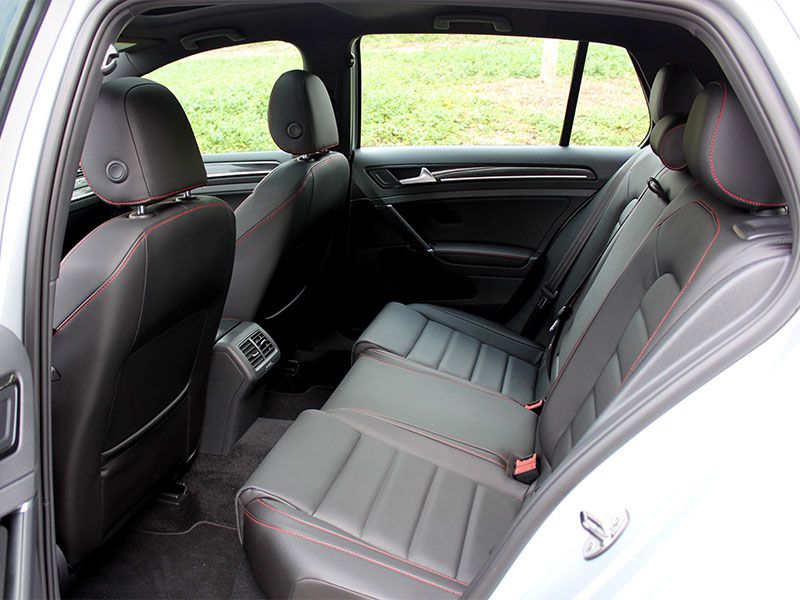
Photo by Miles Branman
High-Class Interior
Yet another claim-to-fame of the GTI has been its upscale interior. Though some would argue that build quality has suffered lately, the GTI’s cabin is by far the most handsome and comfortable of its sub-$30K performance rivals. Bland though the black-on-black layout may appear, the mix of brushed metals and textured materials makes the GTI feel more luxury car than economy. SE and Autobahn trims swap the S and Sport cloth seats (a hallmark of past GTIs) with heated leather chairs. Oddly, only the $34K range-topping version comes equipped with automatic climate control, but all trims receive a 6.5-inch infotainment system. Sport and SE versions can also add a Driver Assistance package ($595) that includes blind-spot monitoring, rear cross-traffic alert, adaptive cruise control, forward collision warning, and autonomous emergency braking. Autobahn models have their own safety tech kit ($1095) with more advanced features like lane-departure warning, automatic high beams, and automated parking.

Photo by Miles Branman
Highs and Lows
Highs: It doesn’t take much seat time in the 2017 VW Golf GTI to tally points of praise. Its hatchback shape means utility, its 2.0-liter turbo motor is both frugal and fun, and its interior and exterior design is handsome. Lows: The GTI’s lows, however—few that there are—aren't as easy to find. take a bit more prodding. The Bridgestone Potenza tires are grippy for street and highway driving, but they stop working so well after a few laps on track. My other gripe is purely a matter of preference. Having owned a GTI, I can speak to the joys of avoiding unwanted attention. But sometimes you might prefer not to be grouped in with the bevy of standard Golfs.
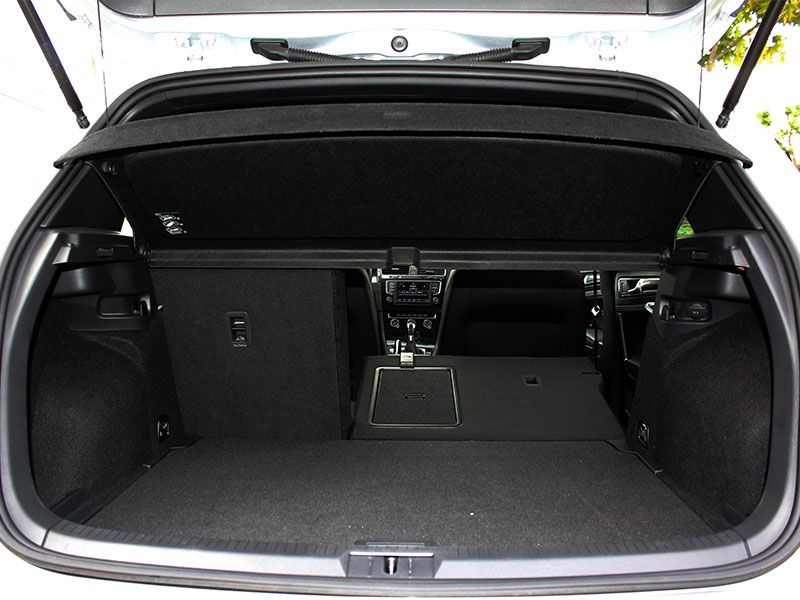
Photo by Miles Branman
Pricing and Packaging
The base GTI, or S trim, starts at $25,595 and is highlighted by cloth seats, three driving modes, and heated seats. The Sport trim tacks on the aforementioned Performance Pack, 18-inch Nogaro wheels, black mirror caps, keyless entry and ignition, LED daytime running lights, Bi-xenon headlamps, and special floor mats, for $27,995. Moving up to the $30,890 SE trim introduces a sunroof, fog lights, leather seats, a Fender audio system, and HID headlights. Finally, the Autobahn range topper bundles all the above with 12-way power seats, navigation, and automatic climate control for $34,095. All GTIs have a $820 destination fee, and DSG is a $1100 option.
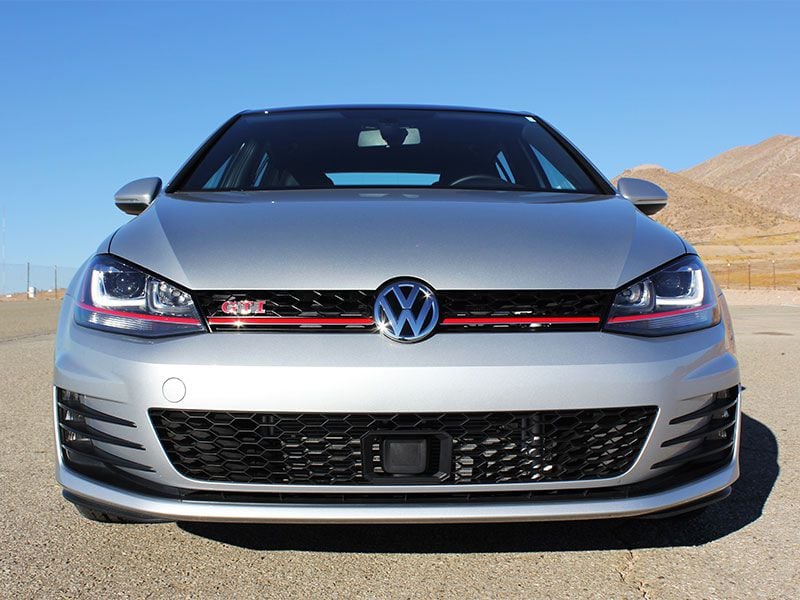
Photo by Miles Branman
Competition
While the 2017 Volkswagen GTI has plenty of foes in the affordable performance vehicle arena, it only has two direct rivals in price and power: the Ford Focus ST (252 hp/$25,300) and the MINI Cooper S (189 hp/$24,950). Despite the power differential, both cars get to 60 mph in 6.3 seconds versus the GTI’s 5.9 seconds. Looking beyond the immediate challengers, things get interesting. The Ford Fiesta ST (197 hp/$22,335) poses a strong threat for those hunting for even more of a bargain. The Subaru WRX (268 hp/$27,390) may not have five doors, but it does have a stellar all-wheel-drive system. Finally, the Mini Cooper John Cooper Works (228 hp/$30,900) does have a convertible version, but its hardtop variant is one spicy hot hatch.
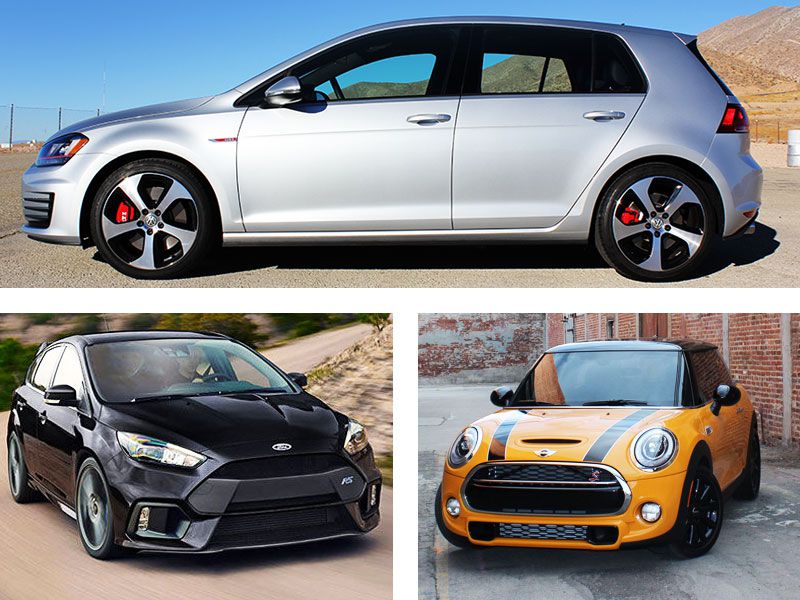
Still The Benchmark
For all the rivals that have come and gone, none have truly unseated the Volkswagen Golf GTI from its throne. Like the Porsche 911’s rear-engine setup, front-wheel drive may not be the optimal performance drivetrain, but VW has fine-tuned the GTI’s mechanics over decades to extract maximum driving pleasure. Drivers with specific styling or handling preferences may find their match elsewhere, but most enthusiasts will conclude that the GTI is still the perfect fit.
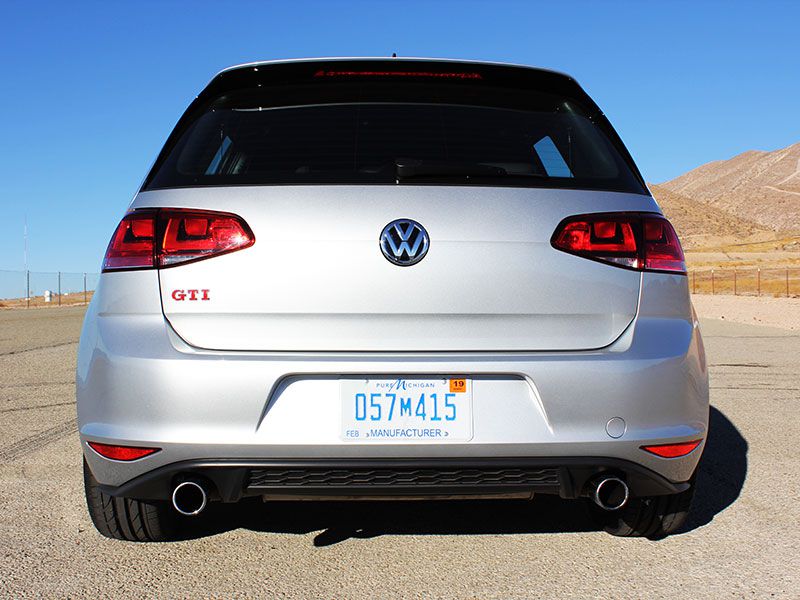
Photo by Miles Branman